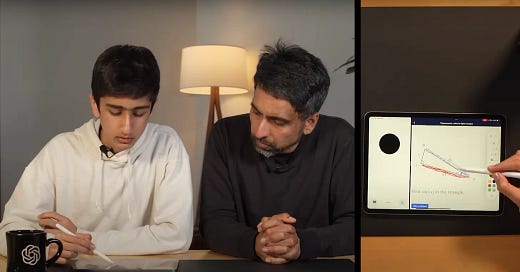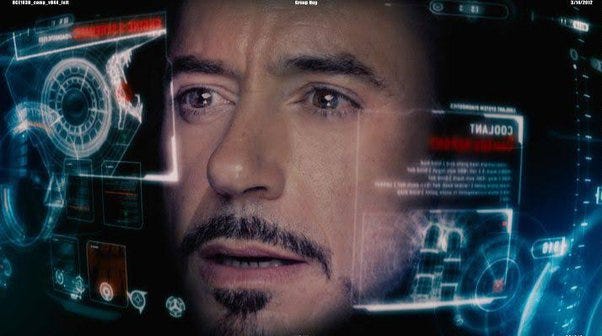How AI will transform education for good
OpenAI and Google showed us that AI won't kill learning
A big week for AI Education
OpenAI and Google shared a series of announcements and live demos this week on their latest AI developments. Both companies announced improvements to their flagship models:
OpenAI revealed GPT-4o, its most advanced model yet with improved vision capabilities and the ability to have a real-time video conversation. ChatGPT is also getting a desktop app.
Google revealed its own version of a real-time video assistance with Gemini Live, Gemini’s expanded context window, AI in Search, its text-to-video tool Veo, and more.
It’s clear that both companies are trying to build a real-world JARVIS.
It was a big week for AI, but an even bigger week for AI in Education.
One of the common themes across OpenAI and Google’s presentations was the focus on applying AI in the context of learning.
Let’s dive in.
AI as a math tutor
The internet’s favourite educator, Sal Khan, featured in OpenAI’s demo of GPT-4o being used as a math tutor.
After sharing their screen with the ChatGPT app (a new feature that will be rolling out soon), Sal asks ChatGPT to help his son Imran solve the math problem without giving him the answer. For the rest of the 3 minutes, ChatGPT and Imran engage in a conversation where they slowly progress towards the solution.
One of the most impressive things was ChatGPT’s ability to detect the lines that Imran was drawing on his iPad and associate them with the questions he was asking:
ChatGPT: Looking at this triangle, which side do you think is the hypotenuse?
Imran: I think it might be this side AC (while drawing a line on side AC, which isn’t the hypotenuse)
ChatGPT: You’re close. Actually, side AC is called the adjacent side of the angle Alpha. The hypotenuse is the longest side of a right triangle and is directly opposite of the right angle.
Eventually, Imran finds a solution to his math problem.
GPT-4o’s improved voice and faster response times made it feel like you’re talking to a real-life tutor standing over your shoulder, guiding you without revealing too much.
Watch the full GPT-4o math tutoring demo (YouTube)
AI as a podcaster
A day after OpenAI’s announcements, Google came in with a radical idea.
Josh Woodward, VP of Google Labs, showed off some impressive updates to Google’s NotebookLM. It’s a tool that basically allows you to upload a set of documents and use it as a research or study assistant. Unfortunately, it’s only available in the US for now…
In his demo, Josh uploaded a set of learning materials related to physics. He then generated an audio discussion based on the material he uploaded. The audio discussion sounds exactly like a podcast between 2 fictional people (AI-generated voices) discussing the material you uploaded in a conversational format.
Even more surprising, the user can interrupt them and ask them a question about the material. For example, Josh asked for a basketball example to explain the laws of motion. It reminded me of how people call a radio station and talk to the radio host live on air. My jaw was on the floor as I watched this entire demo.
Of course, we’ve seen instances of companies faking or overpromising what their AI tools can do so I’ll still want to test this out when I can access it. But the idea behind it is brilliant.
Watch the full NotebookLM demo (YouTube)
The future of education is bright
The overwhelming narrative about AI since ChatGPT came out is that it will destroy education because it makes cheating so much easier.
I can’t deny that. ChatGPT makes cheating a lot easier. You can write essays in minutes instead of hours. You can solve math problems without going through the pain of plugging in your formulas and showing your work.
But we shouldn’t ignore AI’s potential to radically improve education:
#1: Free and accessible AI to all
OpenAI announced that it’s making GPT-4o available to its free users (up to a certain limit), meaning that anyone will be able to use ChatGPT as a tutor.
This will be tremendously beneficial for families who can’t afford a tutor, or when parents are too busy or tired to help their kids with homework every day. Why not use the most advanced AI model, which has been built on humanity’s collective knowledge, to tutor and guide future generations at no cost?
#2: Interactive learning
Google’s audio discussion feature is a radical way of transforming text materials into a more engaging format.
Everyone has a different learning style. I like to read and watch videos to learn, but I struggle to retain information when listening to podcasts and audiobooks.
According to VARK Research, younger people are more likely to prefer auditory learning over reading and writing. It’s the second most common learning preference after kinesthetic learning.
Creating high-quality audio content is expensive, but Google’s NotebookLM has changed that. Now, anyone can upload their notes and generate an engaging podcast out of them. They can also jump in with questions and feel like an active participant, like Josh showed when asking for a basketball example.
#3: Teacher burnout
It should be no surprise that most teachers are burned out.
According to a 2022 Gallup poll, K-12 teachers are the most burned-out workers in the US. Over 40% of K-12 workers (teachers and others) reported feeling burned out "always" or "very often" at work.

Making free and affordable AI tools accessible to students could reduce the burden teachers have in the classroom, as students have access to other support systems.
I expect companies to build specific AI software for teachers to assist with course planning, management, and even grading, to reduce the high workload and stress they regularly face.
Evolving intelligence
At some point in the past 2 years, AI made us ask ourselves: “If AI can do it, why am I learning it and what am I good for?”.
AI is evolving quickly, and our definition of human intelligence should evolve with it.
I can’t help but think of the Sir Ken Robinson talk that I watched a few years ago. He talked about how our approach and beliefs about education need to evolve. The talk was first published in 2007, and you’ll realize that not much has changed since then.
Maybe we needed the AI boom to make us rethink our ways of educating.
If you do one thing this weekend, I hope you watch Sir Ken Robinson’s talk. It’s brilliant, thought-provoking, and hilarious.
Further reading
🔮 The future is too exciting to keep to yourself
Share this post in your group chats with friends, family, and coworkers.
If a friend sent this to you, subscribe for free to receive practical insights, case studies, and resources to help you understand and embrace AI in your life and work.
⏮️ What you may have missed
If you’re new here, here’s what else I published recently:
You can also check out the Year 2049 archive to browse all previous case studies, insights, and tutorials.













Very interesting!